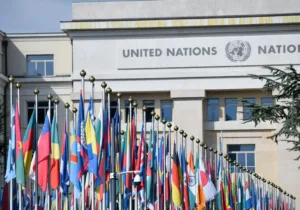It is a common misconception that Christianity is historically the bastion of and main cheerleader for religious freedom and Islam is the poster boy for religious oppression. Despite their disparate theologies, the two religions do have overlapping views of religious freedom. And both are guilty of creating religious freedom deserts, now and again, in numerous lands over the past millennia and a half.
For instance, Christian-led (Catholic) Spain continued its Inquisition for 356 years, torturing, killing, or forcibly converting non-Catholics. Since 1765, Muslim-led (Wahhabi) Saudi Arabia has permitted little to no freedom of religion for all non-Muslims and has heavily regulated Sunni Islam. Conversely, both religions do have “seeds of religious freedom” that have been watered and cultivated to one degree or another for approximately the last 1,500 years.
Two recently published books address these realities, Religious Freedom in Islam: The Fate of a Universal Human Right in the Muslim World Today by Daniel Philpott and Liberty in the Things of God: The Christian Origins of Religious Freedom by Robert Louis Wilken. These works are an illuminating light for the present and a guiding light for the future of the world’s two largest religions, which governments and their citizens are assaulting in many regions of the world.
In 2016, the Pew Research Center reported Christians and Muslims are the most targeted religions in 144 and 142 countries respectively. By 2060, Muslims and Christians combined are projected to be 63 percent of the world’s population.
The number of Christians who face religious suppression is widely published, but the targeting of Muslims is less covered despite their dire situation. For example, China prohibits 11 million Uighur Muslims from celebrating their holy month of fasting, Ramadan. Authorities also have digitally tagged Muslims and monitor their movements closely. In Iraq alone, the Islamic State has killed thousands of Shia Muslims.
These situations reveal Christians and Muslims share a common plight. Wilken and Philpott provide facts, key anecdotes, and strategies that can assist both religions, individually and collectively, as they strive to lessen the amount of violence and discrimination against their fellow brothers and sisters of their respective faiths.
In Liberty in the Things of God, Wilken traces the Christian genesis of religious freedom during the Roman Empire to its development and articulation through the beginning of the Enlightenment. In particular, he notes the advancement of the term conscience. Early on, the conscience’s state of purity was measured by one’s mere obedience to an authority for obedience sake, but a Franciscan friar argued purity of conscience is preserved if one must disobey a lower authority (in his instance, the church) to maintain obedience to a higher authority, God. Another medieval Christian theologian, Godfrey of Fontaines, extended fidelity to one’s conscience to include respect and allowance for one to follow a misguided conscience for “one sins more gravely in violating one’s conscience—even if it is in error.”
This truth was employed by Barolomé de Las Casas in the early sixteenth century when he defended the right of Indians to practice human sacrifice. He believed human sacrifice was evil, but to force Indians to stop was to force them to adhere to principles of the Catholic faith. Religion was no religion at all if one was not permitted to perform its rituals.
Wilken believes all the incremental developments in the understanding of the conscience were synthesized best by an author of an anonymous treatise in 1579. The author, in part, wrote, “Freedom of the soul means freedom of conscience.” And the conscience is “a bond to God,” a reality not afforded by law or decree, but by nature—“a natural right.”
The development of religious freedom not only sharpened the understanding of the God-given conscience, but Wilken also writes it changed the understanding of the relational dynamics between the church and the government. At first, Christians argued they should have the right to believe what they choose. Government should be tolerant of their new belief system. Then they contended government should ensure there be only one Christian religion for the sake of societal peace and cohesion. And those who jeopardize this “Christian society” should either be suppressed, purged, or killed. The Reformation catalyzed this development. Consequently, depending on the country, the officially sanctioned religion was either the Catholic faith or a branch of the Protestant faith.
The final evolutionary step was a dissolution or significant weakening of the relationship between church and state. This occurred because Protestantism produced the local church model. The conception of church membership shifted from being ethnic to being elective. With this step, Wilken writes, freedom of religion had put government out of a job as it pertained to religious affairs. “The task of government was to maintain the republic, not to maintain religion.”
This crucial decision to prohibit government support or favoritism for a certain religion was an integral part of the American Revolution and was codified in the country’s founding document. The same is not true for Muslim-led secular governments that base their governance not on the American Revolution, but on the French Revolution. In his book, Religious Freedom in Islam, Daniel Philpott explains the impact on freedom of religion when Muslim-led countries choose to establish negative secularistic governments based on the French Revolution. As well, he describes religiously free states and religiously repressive states in the Muslim world.
Despite its many beneficial reforms, the French Revolution produced a secular government possessing “a harsh skepticism toward religion,” writes Philpott. The skepticism stems from the belief that religion is a threat because reason (the god of the Enlightenment) guides one to recognize religion as being comprised of “superstition, hierarchy, and ignorance.” So just as the government controls aspects of French religious life, Turkey, Syria, and 13 other Muslim-led countries do the same. The repression in Muslim countries is more severe, however, than it is in France.
Another eye-opening portion of Philpott’s book is the chapter on religiously free Muslim states. They number 11 out of 47 currently Muslim-led countries. Philpott views seven countries in West Africa (WA7) as the exemplars since they are religiously free because of Islam. Alongside those in southeast Asia, Muslims in Niger, Senegal, and the five other WA7 nations are the most devout. Philpott believes this is the case because Islam came to these lands peacefully via traders and teachers. Also, these countries enjoyed a beneficial relationship with European colonial powers. In addition to the robust religious freedom laws in these nations, the relations between Muslims and Christians display a mutual respect to be admired and replicated elsewhere.
Regarding the religiously repressive states in the Muslim world, these countries are more familiar because their oppressive actions often generate headlines in papers worldwide. Iran, Saudi Arabia, Pakistan, and Nigeria are a few in this category totaling 21. One of the most informative portions of this chapter explains why these nations are repressive—Islamism. Philpott asserts Egyptian intellectual Sayyid Qutb is the “most famous Islamist” who propagated the doctrine that Muslims should “remove the chains that constrict other people from seeing and freely embracing the truth of Islam… His [1964] writings, [In the Shade of the Quran and Milestones], inspired a generation of militant jihadis” such as Osama bin Laden and the leaders of al-Qaeda.
The latter portion of Philpott’s book looks at “seeds of freedom” in Islam and a “pathway to freedom.” His seeds of freedom include Quranic texts, historical precedent, current law in many Muslim-majority countries, and liberal Islamic thought that could, with a collective strategy and some concentrated effort, bring the needed change.
In detailing his pathway to freedom (based on the Second Vatican Council’s declaration on religious freedom), Philpott writes about a part of the path less remembered—Christianity’s bloody, persecutory history. It is one of the most crucial points of the book, especially when read in conjunction with Wilken’s book. Reading the books in tandem brings to light how similar portions of the two religions’ histories are.
Philpott specifically mentions the alliances Protestants sought with a monarch or prince to establish the Protestant church as “the religion of the realm.” Dissidents were not tolerated. They were expelled from the country or executed. The prime case in point is England’s King Henry VIII, who once commandeered the English Catholic Church, made it independent from Rome, and executed “powerful [Catholic] dissenters.”
In France, Wilken notes John Calvin sanctioned the execution of a fellow Christian, Michael Servetus, for his heterodox views on the Trinity and Christ. Philpott writes of the anti-religious freedom actions against Catholics following the French Revolution, which included the killing of about 3,000 priests and “genocidal violence against [them] in the Vendée region.”
At the end of the book, Philpott addresses “the fog of cultural war” in the West that continues to keep the topic of religious freedom on the sidelines. The fog is the fractious bickering between the skeptics of Islam and the religious pluralists who welcome Islam. Their very public disagreement “obscure[s] how religious freedom can animate change.” Philpott makes six recommendations to Westerners in hopes of bringing reconciliation.
Two important ones to highlight in this context are 1) religious freedom is a universal human right, not a Western value, and 2) a recognition of Islam’s capacity for religious freedom. Regarding the first, the belief it is a Western value reveals how deeply deficient many in the West are in their knowledge of history. These two books are most helpful in showing Christians in the West that freedom of religion did not begin with the US Constitution or the Universal Declaration of Human Rights. It was not a result of the Reformation or the Enlightenment. The ideal dates back to the third century for the Christian religion. And it is not exclusive to the Christian religion, either. Not only does religious freedom in Islam date back to the seventh century, but it also dates back to the Persian Empire. In 539 BC, Cyrus the Great permitted the Hebrews to return to their land, resume their religious practices, and rebuild the temple. He also extended religious tolerance to other peoples he conquered.
The second recommendation by Philpott directly combats ignorance and prejudice. It is an admonition to those who misrepresent Islam by saying it is antagonistic to freedom of religion. He rebukes them by pointing to the applicable verses in the Quran, “the life of the Prophet Muhammad, the dhimmi tradition, historical instances of liberal Islam, contemporary Muslim advocates of religious freedom, and strands of freedom in law and institutions around the Muslim world.” These debunk the theory that Islam is antagonistic to the human right. He reminds the reader the West African seven are also proof Islam is a legitimate incubator of the free exercise of religion.
For instance, Saudi Arabia’s rule of law states a Muslim who converts to another religion should be put to death. But this law is not based on historical Islam. It is based on Wahhabism, a form of Islamic extremism. Philpott details that the Prophet, on multiple occasions, extended mercy or tolerance toward Muslims who either renounced their allegiance to him or converted to Christianity. And the one instance in the hadith where Muhammad does order the death of an apostate, the person is guilty of robbery, torture, and murder, not converting away from Islam. In fact, the Quran states the apostate will be punished by Allah in the next life.
Philpott makes a key argument in this section when he writes, “The fact that one religious tradition is less religiously free than the rest of the world at a given time does not mean … it is consigned to religious unfreedom. And [the] fact … a religious tradition has not taken the West’s historical pathway to freedom does not mean … no other pathway is available.”
The pathway is going to be different because the societal bedrock of Muslim-led countries is different. In the West, the individual is prized. In the East, community is treasured. The many take precedent over the individual. Hence, the product at the end of the pathway, the actual religious freedom laws enacted by an Islamic nation, will look a little different.
The historical examples from Philpott’s book help the Western Christian understand how this can be so. Wilken’s book reminds Christians religious freedom germinated early on, but its sprouting and eventual blooming was delayed by much brutal antagonism amongst Christians.
Therefore, the church should not expect an instant, Westernized cookie-cutter version of religious freedom in the East. Christians should be patient partners in helping Muslim nations determine how freedom of religion can be adopted into their cultural framework. History reminds us it is possible because freedom of religion is not a Western ideal. It is a God-given aspect of human dignity.





